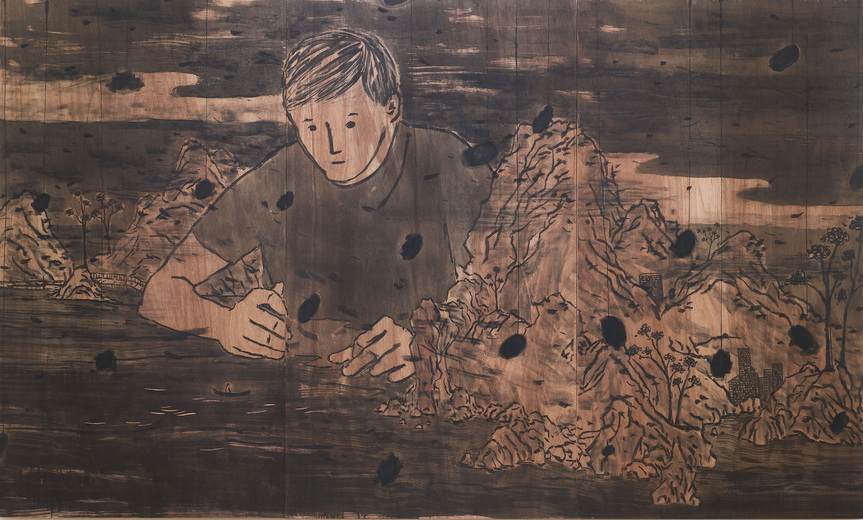-
From Current Issue
-
- Editor’s Letter Fire in the Heart
- Reviews I Gusti Ayu Kadek Murniasih
- Reviews 11th Seoul Mediacity Biennale: “One Escape at a Time”
- Dispatch Networked China
- One on One Monira Al Qadiri on Yukio Mishima
- Essays The rise of independent art spaces in pandemic-era Shanghai
- Features Tuan Andrew Nguyen
- Table of Contents
- Web Exclusives
- Archive
- Subscribe

R
E
V N
E
X
T
Installation view of “Ink City,” at Tai Kwun Contemporary, Hong Kong, 2021. Photo by Kitmin Lee. Courtesy Tai Kwun Contemporary.
According to the introductory wall text of “Ink City,” the show’s 19 featured artists, from different generations and regions, “have an inclination towards ink art, however broadly or narrowly defined, and . . . articulate a voice on the notion of living together in a contemporary urban environment.” The ink paintings near the exhibition entrance were closely aligned with the preface’s description. Lam Tung Pang’s three-meter-wide Reforming Landscape (2019) portrays an individual molding mountains between his hands, hinting at how humans have shaped territories, including through land-reclamation projects that have become pervasive as populations expand. Luis Chan’s Illegal Immigrants (1985) illustrates a crowd in colorful clothes squeezing over a wall next to a harbor, alluding to Hong Kong’s influx of new residents from the 1960s to the ’90s. Chu Hing-Wah’s The Old Lady’s Great Love (2016) captures a woman leading a blind man down a street with retro signs for saunas and nightclubs, stirring a nostalgia for the past. Through the language of ink, these paintings by three generations of Hong Kong artists all address the rapid changes of a densely populated city, offering glimpses at various aspects of urban life.
However, further into the exhibition, the curation became increasingly loose and confusing, requiring viewers to figure out how the works have “shared narratives and sensibility,” as the introduction states. For example, Joey Leung Ka Yin’s The Listless Lion (2017) is a playful diptych where a lion rests on hills formed by a series of female legs—a motif in Leung’s work that references the traditional Chinese painting genre of shinu, which originates from depictions of folkloric fairies. Leung has been using shinu motifs in recent years to create a sense of detachment from reality. Here, couched in her fantastical style, the imagery of and witty poem about an exhausted lion suggest that Hong Kong’s “Lion Rock Spirit”—an ethos of collective strength that emerged during the city’s industrialization in the 1970s—is now but a myth as factories have declined. Leung’s diptych was placed next to Walasse Ting’s unabashed celebration of individual desire and hedonism in his green-hued ink-and-acrylic painting of a female nude lying on grass, Beauty Fantasy (c. 1990s). While both paintings feature female body parts, I wasn’t able to connect Leung’s sharp, humorous narrative to Ting’s illustration, which is a product of his male gaze.
Dizzying jumbles of works abounded elsewhere. On another side of the gallery, a batch of paintings appeared to be conflated under the theme of womanhood. Viewers could hear a narrated stream of consciousness on bullying among schoolgirls, part of Tao Aimin’s confessional, calligraphy work, Nü Shu: When Girls Try to Break Each Other (2020), while looking at Evelyn Taocheng Wang’s painting about menstruation and pain, Don’t take painkiller (2018). As one moved further along the wall, these meditations on suffering and toxic same-sex competition were stopped abruptly by Leung’s surreal painting Dream Balcony (2016). The female figures in a crowded bathhouse nod again to shinu paintings, but the balconies protruding from the women’s bodies center the issue of unauthorized construction in Hong Kong. The exhibits continued with another painting by Wang that muses on her personal experience of working in a massage parlor in Amsterdam and Sherry Fung Hoi Shan’s technique-focused Tête-bêche (2020), compositional experiments that portray two deer drinking from a water fountain and a lake. As a result, the section appeared to be a random selection of female artists, whose concerns were obscured.
Throughout my visit, the show was frequented by local citizens of all ages and genders. One could say “Ink City” was successful in assembling artists that appeal to a broad audience and in inviting new perspectives on ink art. A muddled display could have perhaps been justified by these outcomes. But in these casual groupings of works, there was also the undermining of pain and individual expression. A particularly pressing instance was the placement of Tsang Tsou-choi’s two electric boxes, which were covered in calligraphy declaring Tsang’s ownership of Kowloon, across from Yang Jiechang’s monumental painting Massacre (1982), which features decapitated heads and blood puddles as an expression of the Cultural Revolution’s traumas. “Ink City” left me disoriented amid the complicated sentiments and histories that each work conveyed.
Pamela Wong is an assistant editor at ArtAsiaPacific.
“Ink City” was on view at Tai Kwun Contemporary, Hong Kong, until August 1, 2021.
To read more of ArtAsiaPacific’s articles, visit our Digital Library.















